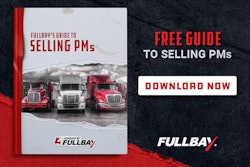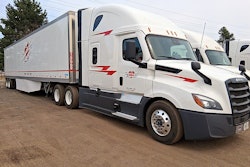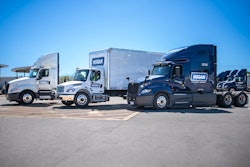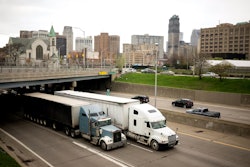Whether it’s a near-term and immediate problem like freight demand and contract terms or long-term challenges such as sustainability and demographic shifts, this year’s CCJ Fall Symposium focused on managing through change. A couple hundred executives gathered last month in Scottsdale, Ariz., for the 2007 CCJ Fall Symposium.
The invitation-only Symposium was sponsored by Communications Development, Cummins Inc., Fleet One, Freightliner Trucks, Goodyear Tire & Rubber, Qualcomm, Roadranger, Shell Lubricants and TravelCenters of America.
The following are recaps of several of the presentations at this year’s CCJ Fall Symposium. In addition, attorney Henry Seaton of the firm Seaton & Husk addressed the scourge of double brokering, and Barry McGrady, vice president of information technology for Floyd & Beasley, presented his company’s performance-based driver pay structure.
For copies of all the presentations in PDF format, click on these links.
http://www.rrpub.com/ccj/07_fall_symposium/costello_ccj_fall_symposium_2007.pdf
http://www.rrpub.com/ccj/07_fall_symposium/kuntz_ccj_fall_symposium_2007_final.pdf
http://www.rrpub.com/ccj/07_fall_symposium/little_ccj_fall_symposium_2007.pdf
http://www.rrpub.com/ccj/07_fall_symposium/mcgrady_ccj_fall_symposium_2007.pdf
http://www.rrpub.com/ccj/07_fall_symposium/seaton_ccj_fall_symposium_2007.pdf
Costello: Recovery is slow but sure
A prolonged slump in housing and a slight bump in trucking capacity are among the reasons why a recovery is unlikely before the second quarter of 2008, says Bob Costello, vice president and chief economist of the American Trucking Associations. But as difficult as these times are for many, it’s important to remember that they are temporary. “In the long run, this industry will do very well,” Costello says. “The biggest challenge will be how to handle all the freight coming our way.”
Even now, there are signs of strength, Costello says. In 2006, the number of loads in the truckload segment grew a mere 0.3 percent over 2005, but the nation’s truckload fleet rose a net 2.3 percent, principally due to the pre-buy, he says.
“This year, the dynamic is opposite,” Costello says. In 2007, truckload loads had risen 1 percent through August, while the truckload fleet had declined 1.1 percent on a net basis. Costello expects that 1 percent rise in loads to soften by the end of 2007, but the overall trend is positive. “The fundamentals are still there to support tighter capacity.”
The picture on the demand side is not so rosy, Costello says. The housing market likely won’t rebound until 2009, and, according to Federal Reserve data, manufacturing growth has declined from a peak in mid-2006. But for trucking companies, the outlook for manufacturing is even worse. The Federal Reserve looks at the value of manufactured goods, but Costello adjusts the data to offer a weight-based view. “The United States is producing high-value, high value-added products, and those tend to be low weight,” he says. And the weight of goods produced is more important for trucking companies.
Through October, the number of employees working for trucking companies had fallen by almost 15,000, Costello says. But LTL carriers and large truckload carriers cut even more than that. During the first half of 2007, small truckload carriers increased their employment levels despite the soft freight. With recovery slow in coming, this is a troubling trend for small carriers, Costello says.
– Avery Vise
Kuntz: Green means burning less fuel
Onerous carbon taxes and cumbersome cap-in-trade regimes in order to reduce greenhouse gases would hurt the trucking industry and would not necessarily achieve a meaningful reduction in carbon dioxide (CO2), American Trucking Associations Chairman Ray Kuntz says. Kuntz, who is chief executive officer of Helena, Mont.-based Watkins & Shepard, says that Environmental Protection Agency regulations aimed at cutting other pollutants have made the CO2 challenge greater.
“While our industry has a tremendous track record in cleaning up the nation’s air through advanced engine technologies and cleaner fuels, we have experienced a major setback in that we have also witnessed fuel economy losses as a result,” he says.
In June, Kuntz appointed a sustainability task force to consider alternatives to drastic measures that have been proposed at the federal level and in individual states. The panel advanced some concepts in July, and ATA staff now has estimated the impact of those recommendations.
The general thrust of ATA’s effort is to promote fuel efficiency among both large trucks and cars through a variety of measures, Kuntz says. For example, an enforced national speed limit of 65 mph would save 11.5 billion gallons of fuel – 2.8 billion gallons for trucks and 8.7 billion gallons for cars – over a 10-year period, ATA says. That translates into a reduction of CO2 emissions by 116.2 million tons over that 10-year period. Other savings include reducing discretionary idling and adopting the recommendations of EPA’s SmartWay Transport Partnership.
According to ATA, the greatest reductions in fuel use and CO2 emissions would come from reducing nondiscretionary idling by eliminating congestion in urban areas and allowing trucks to haul more freight per load. Regarding congestion, the greatest savings would be for cars, which would reduce fuel burned by 27.7 billion gallons and C02 emissions by 268.5 million tons over 10 years. Increasing the gross maximum weight for trucks would cut fuel usage by 20.5 billion gallons and CO2 emissions by 227.3 million tons.
Altogether, recommendations of ATA’s sustainability task force would save 86.1 billion gallons of fuel over 10 years, representing 904.7 million tons of CO2 that otherwise would be emitted, Kuntz says.
– Avery Vise
Steve’s seven steps for success
Companies that manage growth well over the long run generally exhibit some common traits, says business growth consultant Steve Little. Little, who led several high-growth companies during the 1980s and 1990s, today is an author, frequent lecturer and senior consultant for Inc. magazine. Seven of the most important traits are:
- A strong sense of purpose. “Money doesn’t work long-term,” Little says.
- Outstanding market intelligence. “Recognize change is happening, and proactively do something about it.”
- Effective growth planning. According to an Inc. magazine study, only 12 percent of privately held companies have a written plan that is well communicated and regularly updated, but 80 percent of the Inc. 500 do. “The plan itself won’t lead to growth. It’s the process of planning.”
- Customer-driven processes.
- Savvy use of technology. “If you aren’t an expert in the tools of our time, you better become an expert,” Little says. But recognize that an over-reliance on technology can actually undermine a customer-driven process by encouraging personnel to follow a strict menu of options, he adds. A huge fan of vanilla milkshakes, Little frequently finds that he can’t order one from hotel room service. When he’s told the restaurant doesn’t sell milkshakes, he asks instead for a half-glass of milk, vanilla ice cream and a long spoon. Often, that’s exactly what he gets. The person on the other end of the phone is merely filling orders the computer lets him fill rather than fulfilling customer needs.
- Hiring the best and brightest. “If you are a CEO, this is your job,” Little says. “Employee retention equals customer retention equals growth.”
- Seeing the future. “Business growth leaders spend over half their time on the issues of tomorrow.” Little talked about such issues as population shifts into cities, the aging of the population and the opportunities in being “green” and Latino-friendly.
Ultimately, the white-male-dominated business world must come to grips with the most fundamental change of all, Little argues. In 1776, Caucasians represented half the world’s population. By 2050, they will be 4 percent. Businesses that don’t accept and embrace this reality will find growth – even survival – very difficult, Little says. “We’ve had a good run, but it’s over.”
– Avery Vise










